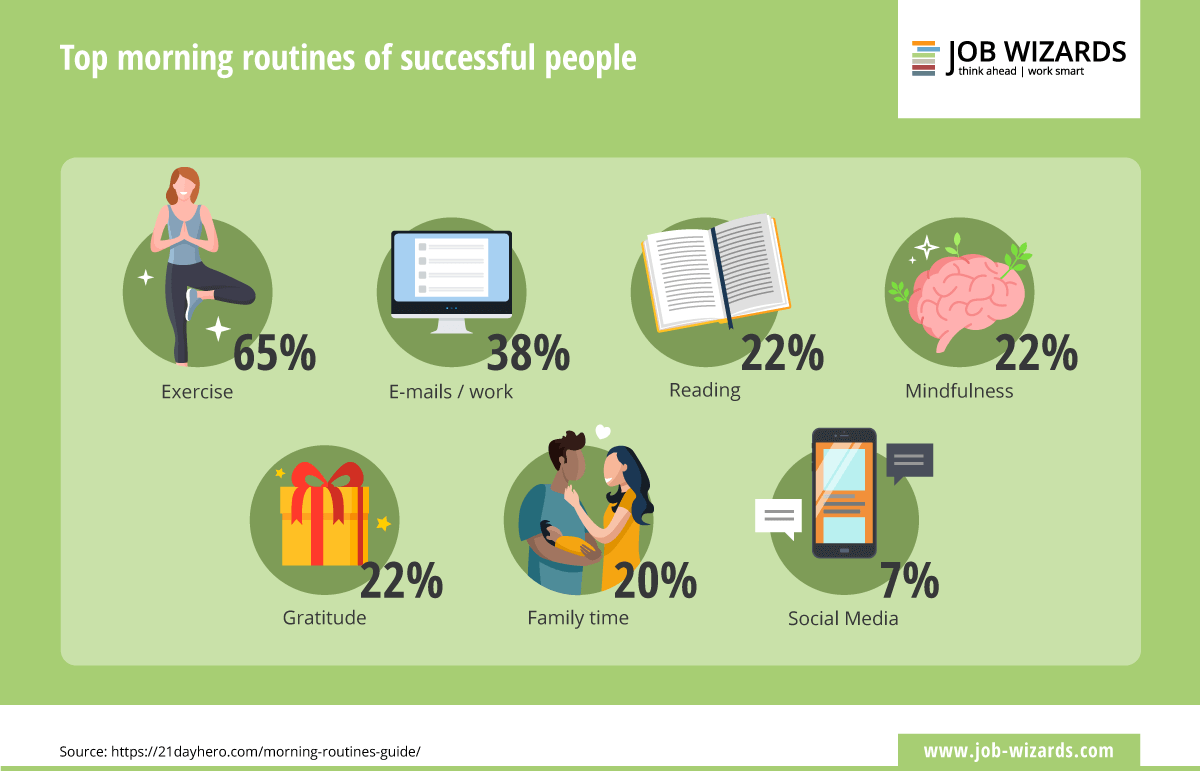Those who are aware of their own biological rhythm and develop suitable work routines enjoy clear benefits. This can be seen in the daily routines of super-successful and efficient entrepreneurs.
Even if it can be nice to start the day slowly: successful people don’t allow themselves that luxury. Instead, they often have a meticulously structured day that is optimally harmonised with their personal performance curve.
Billionaire CEO of Twitter and Square, Jack Dorsey, for example, who after exactly seven hours of sleep starts his day with a morning ice bath. Tuesdays and Thursdays he works from home, because he can think better there. He skips breakfast and lunch in order to stay focused, and has his first meal in the evening.
Albert Einstein, in contrast, is said to have enjoyed ten hours or longer in bed, and gained important insights for his theory of relativity in his sleep. There’s no doubt: people and their optimal performance vary greatly.
People and chronobiology: what makes our body ‘tick’?
Dorsey’s habits are certainly at the more extreme end of the scale when it comes to making the most of your own performance potential, but they represent a trend that is becoming increasingly widespread: working under optimal conditions. And what that means can vary greatly from one person to another.
Scientists have discovered that every person, and every organism, has a kind of internal clock. This functions like a set rhythm, genetically determined, that decides what makes us ‘tick’ – whether we prefer to get up early or late.
Chronobiology is the study of these biological rhythms: our body’s own chronometer; specific genes oscillating in almost all our cells and in our brain provide an individual beat for the discharge of hormones and our sleep–wake behaviour.
In this context, the change between day and night – the natural light–dark rhythm – is the most important timer for the biological clock. However, since the creation of artificial light, it has been increasingly confounded. This is because while natural light sources like fire or candles have a more reddish hue, the blue light emitted by smartphones, televisions and tablets is on a very different wavelength, which primarily signifies activity to the human body.
Every organism is different, but there are two chronotypes
There are two primary ‘chronotypes’: firstly, the early risers, or larks, who always wake very early. For example the British entrepreneur Richard Branson, founder of the Virgin record company and the Virgin Group, who wakes up at 5 a.m. every morning. Then there are the more nocturnal long sleepers, or night owls, who don’t turn off the lights until late at night, like to sleep in and for whom work always starts far too early.
‘New Office Hours Aim for Well Rested, More Productive Workers’ was the headline in the New York Times as long ago as late 2018. The article describes in detail how more and more companies are encouraging their employees to work when their body is most awake, with the help of flexible working hours.
Earlier, today, tomorrow: working in harmony with the internal clock
However, many employees are not yet aware of the existence of this internal clock. And working in harmony with it has not reached all sectors – far from it, in fact. ‘Our body is dominated by inner rhythms that we only notice when something goes wrong, for example if we live in conflict with our internal beat over a sustained period and only follow the external societal, abstract time’, writes author and philosopher Rüdiger Safranski. He goes on: ‘The damage to health done by long shift work is known. It brings about sleep problems, depression and cardiovascular disorders. If you stubbornly live in conflict with your body’s own time setting, you won’t live long.’
Chronobiology: potential for the workplace of the future
‘If you want to attract and retain specialist staff in future, you need to think beyond extrinsic (editor’s note: coming from outside) motivation factors. Generation Y expect a work environment that takes their individual needs into account,’ explains Michael Wieden, author of Chronobiologie im Personalmanagement (Chronobiology in HR Management). Paying more attention to the internal clock at work and when planning work time is an interesting and promising approach.
In this way, the workplace of the future offers new opportunities to address employees and bear in mind how they individually can work best. That is healthier for employees and more productive for employers, because those who learn to work in harmony with their own biorhythm stay healthy and can perform to their full potential under optimal conditions.
Internal clock and biorhythm: how to optimally orient them
Are you interested in chronobiology? Start with a self-observation log to get to know your biorhythm better. Pay attention to what your most active time of the day is. Use that time to complete important tasks. Note in a table with an hourly or bi-hourly rhythm at what time you do what work and whether you are awake or tired, concentrated or distracted, fast or slow, creative or not at the time.
In general, most people are full of energy in the morning. After lunch many hit a dip in performance, followed by a second peak in the late afternoon. Then the body gradually shifts into night relaxation mode – except for the night owls.




